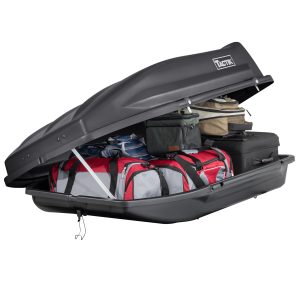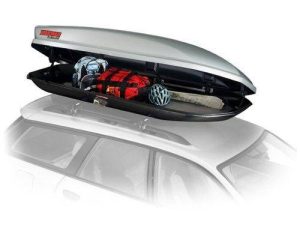“How to pack a roof box?”. A question that almost all car owners have asked.
Whether you are thinking about buying a roof box carrier or have just bought one, there are a lot of things that you need to know about packing and traveling with one on top of your car.
Understanding everything that could go wrong and how to prevent it will help you have a hassle-free vacation.
Table of Contents
Key Takeaways
- Know your roof box weight limit to prevent overloading.
- Distribute weight evenly for safe driving and handling.
- Choose the right items and secure them properly to prevent damage and accidents.

One of the biggest concerns when packing your box carrier is overloading it, so the first thing that you want to do is determine what the weight limit is.
Both your vehicle and your box carrier will have separate weight limits and while they will usually be high enough that there is no worry of exceeding them, you still want to know what they are.
Your carrier’s weight limit should be in the instructions somewhere and if you take all of the following advice, you should have no problem loading your box carrier safely and efficiently.
How to Pack a Roof Box Like a Pro
1. Know the weight limit
 Exceeding the weight limit can cause damage to your vehicle and roof box, and even pose a safety hazard on the road.
Exceeding the weight limit can cause damage to your vehicle and roof box, and even pose a safety hazard on the road.
To find and understand the weight limit of your roof box:
- Check the manufacturer’s manual or website for the specific weight limit.
- Consider the weight distribution of your cargo.
- Use a luggage scale to weigh your packed items before loading them into the roof box.
- Do not exceed the weight limit to ensure safe and secure transport.
The weight limit of a roof box varies depending on the maker and model. It is important to consult the manufacturer’s manual or website to find the specific weight limit for your roof box.
2. Pack the heaviest things in the car first
If you are planning on using your car and have a decent amount of trunk space, you should start with that. Once you load things in your car up to a reasonable height, usually just before the back windshield begins, you can start putting the rest up in your rooftop carrier.
Start with the heaviest or boxiest items in the car because your trunk will have a higher weight limit than your rooftop.
3. Put your suitcases in your overhead storage
 Most rooftop storage boxes are designed in a way that makes them perfect for suitcase storage. You should have no problem laying suitcases and bags side by side in your rooftop box.
Most rooftop storage boxes are designed in a way that makes them perfect for suitcase storage. You should have no problem laying suitcases and bags side by side in your rooftop box.
It will often be loose enough so that they all fit comfortably, but tight enough so that they aren’t sliding all over the place. If you can fit your suitcases up top, think of all the free trunk space you’ll have for the rest of your stuff.
4. Put your sports equipment up top
If you are traveling for a sports-related reason or are simply taking your gear with you, these things are often better in an overhead storage box. Specifically, things such as skis or snowboards often fit nicely in a rooftop cargo box and some of them are specifically designed with this purpose in mind.
Having long, awkward items in the box means that they aren’t getting in anybody’s way inside of the car.
5. Distribute the weight evenly
 Proper weight distribution is crucial when packing a roof box for a road trip. Unevenly distributed weight can lead to handling problems, reduced fuel efficiency, and even damage to the roof box or vehicle.
Proper weight distribution is crucial when packing a roof box for a road trip. Unevenly distributed weight can lead to handling problems, reduced fuel efficiency, and even damage to the roof box or vehicle.
It is recommended to distribute weight evenly across the roof box to avoid any issues. This means placing heavier items in the center of the box and lighter items towards the edges.
Here are some best practices for roof box packing to ensure even weight distribution:
- Use packing cubes or bags to organize items and distribute weight evenly
- Place heavier items such as suitcases or camping gear in the center of the roof box
- Place lighter items such as pillows or blankets towards the edges of the roof box
- Avoid leaving empty spaces in the roof box as it can cause items to shift during transit
- Secure items with straps or bungee cords to prevent movement
6. Take advantage of any straps or holders
 Many storage boxes will come with various straps or holders on the inside and you can use these to secure certain items. Doing so ensures that you can control movement as much as possible and that you minimize noise during your travels.
Many storage boxes will come with various straps or holders on the inside and you can use these to secure certain items. Doing so ensures that you can control movement as much as possible and that you minimize noise during your travels.
If your storage box has ski holders, you can even use these as compartment dividers and separate your belongings while also keeping them more secure.
7. Wrap things in plastic
Your box carrier should have no problem keeping your belongings dry in the rain as they are sealed and secured with locks. However, as an added precaution, you might want to consider wrapping certain things in plastic bags, especially if they are valuable.
Some box carriers and storage bags may struggle in really heavy rain and while the chances are pretty low that your things will get wet, you can never be too careful.
8. Keep the locking system clear
 You will be relying on the locking system for your storage box to keep your belongings secured so you will want to be conscious of these components when you are loading. If you block them or obstruct the closing of the lid in some way, your storage box may wind up springing open as you are driving down the road.
You will be relying on the locking system for your storage box to keep your belongings secured so you will want to be conscious of these components when you are loading. If you block them or obstruct the closing of the lid in some way, your storage box may wind up springing open as you are driving down the road.
Some rooftop boxes will have more than one lock so just double-check and make sure that they are all locked properly before you leave.
9. Tie down the box
As another act of precaution, you can tie down your rooftop box with straps or bungee cords simply to give yourself some peace of mind. The box itself should be reliably secured to your roof but if you want that added protection, don’t hesitate to throw some straps across it after you have gotten everything loaded.
10. Get somebody to help you load
 One of the main reasons why getting help is important is because it can be difficult to lift heavy or bulky items onto the roof of your car by yourself. This is especially true if you have a high roof or a large vehicle. Having someone to help you lift and position items can reduce the risk of injury and make the process much smoother.
One of the main reasons why getting help is important is because it can be difficult to lift heavy or bulky items onto the roof of your car by yourself. This is especially true if you have a high roof or a large vehicle. Having someone to help you lift and position items can reduce the risk of injury and make the process much smoother.
When getting help, it’s important to communicate clearly and work together to ensure that the load is safe and secure. This might involve using straps or bungee cords to secure items, or adjusting the position of items to ensure that the weight is distributed evenly.
Weather Considerations
 When packing a roof box, it is important to consider the weather conditions you may encounter during your trip. Weather can have a significant impact on your packing strategy, and failure to prepare for adverse conditions can result in damage to your belongings or even accidents on the road.
When packing a roof box, it is important to consider the weather conditions you may encounter during your trip. Weather can have a significant impact on your packing strategy, and failure to prepare for adverse conditions can result in damage to your belongings or even accidents on the road.
Weatherproofing your roof box
Before you start packing, make sure your roof box is properly weatherproofed. This means checking for any cracks or gaps in the box and sealing them with silicone or other weatherproof sealant. You should also ensure that the box is properly secured to your vehicle and that the locks are functioning properly.
Dealing with rain
If you are traveling in rainy conditions, it is important to take steps to protect your belongings from moisture. You can do this by using waterproof bags or containers to store your items inside the roof box. You should also pack items that are sensitive to moisture, such as electronics or clothing, in sealed plastic bags.
Dealing with snow
 If you are traveling in snowy conditions, you should take extra precautions to ensure that your roof box is properly secured and that your belongings are protected from the elements. You can do this by using a snow cover to protect the roof box and by packing items in waterproof bags or containers.
If you are traveling in snowy conditions, you should take extra precautions to ensure that your roof box is properly secured and that your belongings are protected from the elements. You can do this by using a snow cover to protect the roof box and by packing items in waterproof bags or containers.
Other weather conditions
 In addition to rain and snow, there are other weather conditions that you may encounter on your trip, such as high winds or extreme heat. In these cases, it is important to take appropriate precautions to ensure that your roof box and belongings are protected. This may include using additional straps to secure the roof box or packing items in insulated containers to protect them from extreme temperatures.
In addition to rain and snow, there are other weather conditions that you may encounter on your trip, such as high winds or extreme heat. In these cases, it is important to take appropriate precautions to ensure that your roof box and belongings are protected. This may include using additional straps to secure the roof box or packing items in insulated containers to protect them from extreme temperatures.
Here's some more tips from Roof Box makers, Yakima





